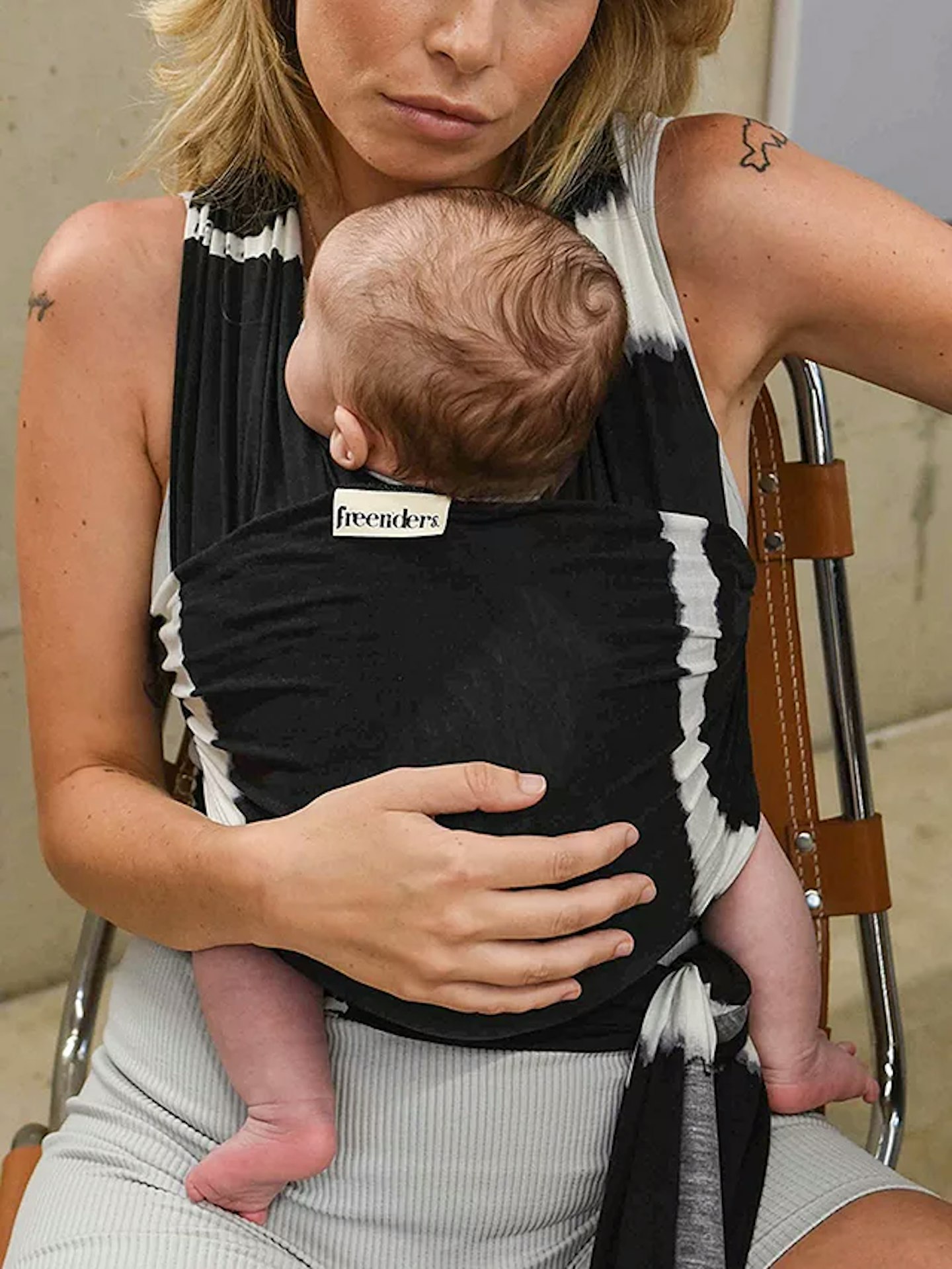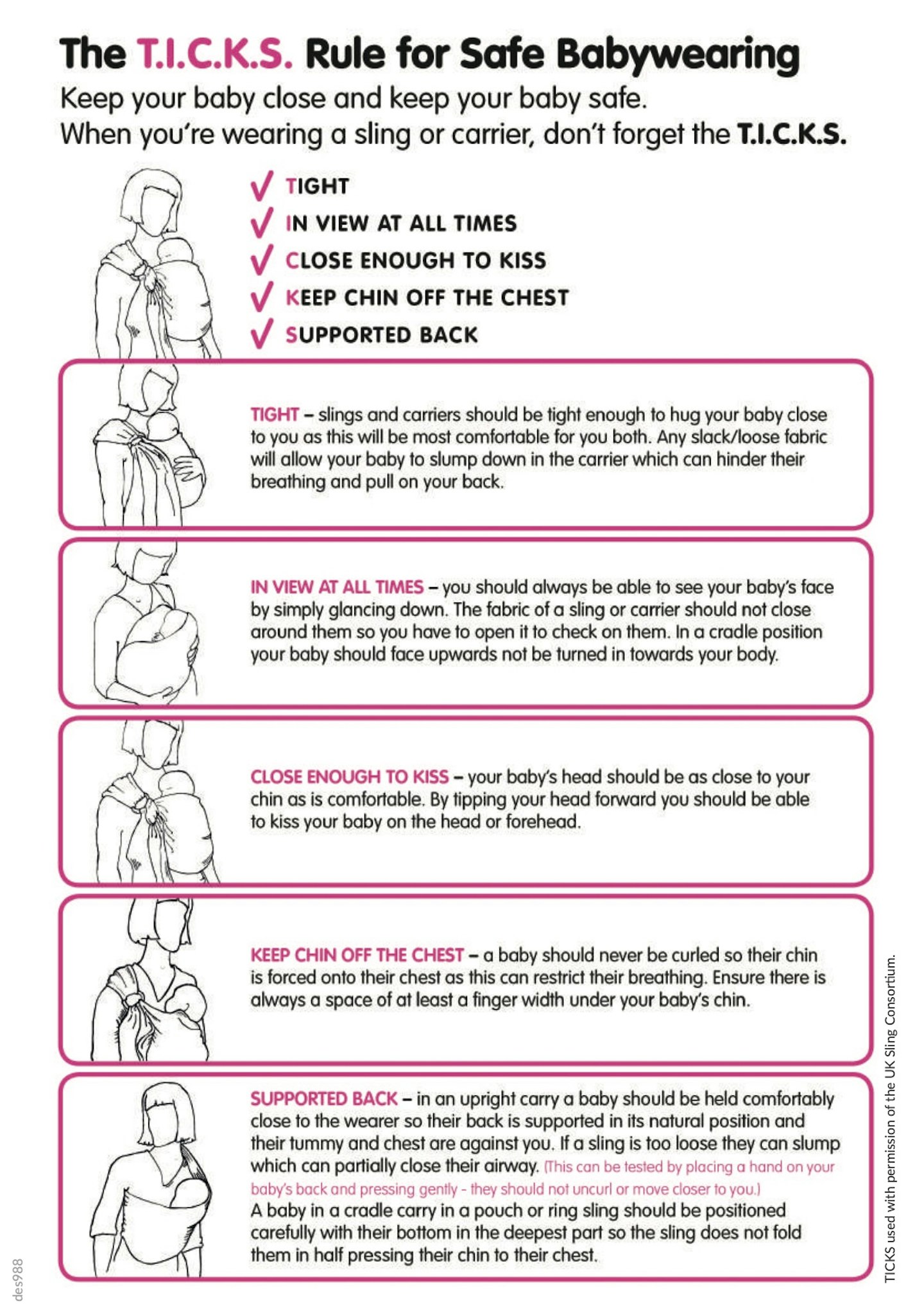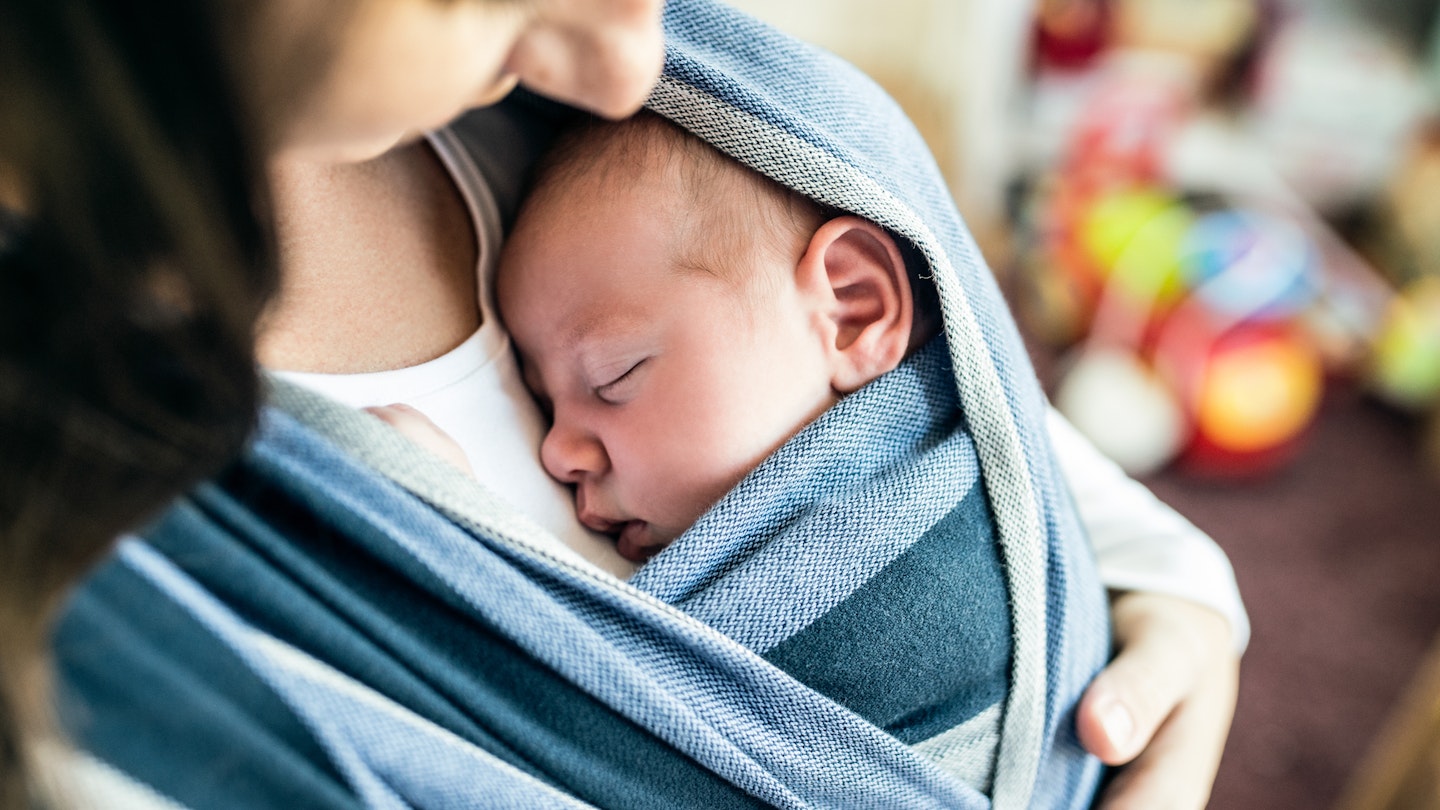If you're a soon-to-be new parent, chances are you'll have noticed many parents carrying their babies in slings and baby carriers. Also known as 'babywearing,' the idea is that you keep your baby close to you, warm, safe and happy. And the best bit? You can do this and stay hands-free, and we're here for that!
To confidently navigate the world of babywearing, we spoke with award-winning babywearing expert and Carrying Consultant, Dr Rosie Knowles. Dr. Rosie offers an informed perspective as an advocate for babywearing, a practising GP, author, and mum of two. She says, "A well-designed carrier that fits properly can be a wonderful tool for families." She helps to explain how to safely and comfortably use a baby carrier. Also, she describes the benefits babywearing offers, as well as what not to do while babywearing, later in the article.
What is babywearing?
Babywearing is precisely what it says on the tin: you wear your baby. This can be in the form of a baby carrier, a baby sling, or a baby rucksack—the options are endless. Dating back thousands of years, simple one-shouldered carriers, originally made from natural materials like bark and animal skins, helped parents transport children. Eventually, cloth carriers became common, securely tying babies to adults or siblings.
The term 'babywearing' was coined in the 1980s after a Hawaiian man invented a sling for his wife and sold his idea to an American Doctor. The doctor's wife invented the term after using a sling with their son.
Babywearing has evolved over the years as the need for practical items in the fourth trimester has helped new parents better navigate the world with a little one close to them.
What are the benefits of babywearing?
Babywearing is an effective way of comforting an irritable or fussy baby, and can also have a relaxing effect on you. The science behind this shows that being close to your baby triggers your brain to release the hormone oxytocin, often called the ‘love hormone,' which will help you feel calm and content.
Dr Rosie says, "Mums feel better for the cuddles, but also because they become confident that they can calm their baby, meet their needs and still be hands-free to do what they want to. Babywearing is an age-old practice that helps life to work."
Parents may worry that babywearing can negatively impact a child's independence and physical development, but on the contrary, the opposite is true. "Building a happy brain that is confident and secure is essential to a child’s long-term wellbeing," says Dr. Rosie, "Most people who carry their children a lot in the early months find that this helps them feel more able to explore the world around them, as they are very sure of their parent being there when they need them."
The calming effect: Baby carriers and slings are a great source of comfort for your baby. Keeping them close to your chest means they can hear your heartbeat and feel your body warmth. Close contact also helps regulate your baby’s temperature, breathing, and heart rate. Your movement also mimics your baby's comforting rocking motion in your womb.
A Columbia University in New York study found that using a soft baby carrier helped promote bonding and made mothers more responsive to their babies' needs. This secure attachment also helps babies develop positive emotional development. Rosie also mentions, "Babies with colic can be hard to soothe, but the motion gained from being gently rocked while the parent walks often helps settle them. A good carrier encourages an upright position, which can reduce posseting and reflux, and a spread squat position helps aid bowel elimination."

The convenience: You're hands-free and can go about your daily tasks with both arms and hands available, and who wants to manoeuvre a pram on a busy road?
Share the load: You can make others feel part of the bonding process by alternating between you and your partner or with the grandparents. This also lessens the literal burden to just one person.
Safety when babywearing
To make babywearing an enjoyable and relaxing experience, it's essential to consider safety.
Make sure baby is safe in their carrier by following the TICKS rule:
T - is for Tight. Your carrier should be close-fitting to ensure it holds your baby in a safe position.
I - is for In view at all times. Ensure you can clearly see your baby’s face so you can check on them easily.
C - is for Close enough to kiss. You should be able to kiss the top of your baby’s head easily while in the carrier, but make sure they can still move their head freely.
K - is for Keep chin off chest. "His chin should be off his chest and his airway open and unobstructed, and remain so if he falls asleep," says Rosie.
S - is for Supported back. ‘The sling should be snug so baby’s chest and back are well supported, with no slumping or sliding downwards,’ says Rosie.

Can you breastfeed while babywearing?
Dr Rosie advises against this, saying, "It has never been safe to feed a baby hands-free in a carrier. A parent should always be focused on their baby’s breathing, checking it repeatedly and having one hand on the baby at all times. Babies with blocked noses or who are unwell should be monitored vigilantly in carriers."
She also explains that there must never be any fabric behind the baby’s head during a feeding and that the baby’s face is never pressed into breast tissue. "They must always be able to move their head freely during the feed. This is why a supportive hand from a parent is needed, not a headrest. When baby has finished the feed, they must be repositioned to a safe upright position, or taken out of the carrier. Babies should never be left to sleep in a feeding position. This can block their airways."
Jenny Ward, CEO of The Lullaby Trust, agrees and says, "'Hands-free’ breastfeeding or bottle feeding, where the wearer moves around and does other jobs while the baby is feeding, is unsafe. This is especially true for babies under four months old. It also applies to babies born prematurely or those with a health condition. Moving around with loose sling fabric could also be a trip hazard. If the baby needs to feed, take them out of the sling. When they have finished feeding, return them to the sling or put the baby down in a safe space."
When can a baby face forward in a baby carrier?
According to Dr Rosie, this is usually from 4-6 months, depending on the strength of the baby’s neck and torso. "They should be able to hold their head and upper body upright without tiring for at least 20-30 minutes. Babies should never sleep facing out; they must always be turned around if they are tired, to face their parents. Airways can become obstructed if the neck is curled onto the chest. Ring slings and hip carriers are an excellent option for increased visibility for curious children as they can fall asleep in these as they remain facing the parent’s body," she explains.
Around the same time, your baby develops good head control and can keep their head upright for prolonged periods. They'll also want to start looking around and see what else is going on in the world. This indicates that they're ready to face forward in their baby carrier.
Are slings safe for newborns?
While slings and baby carriers are safe for babies and may seem like the answer to all your problems, when they're not used safely, they could put your baby at risk. Dr Rosie warns that not all carriers are suitable for small babies despite their labelling, marketing, or popularity. "Manufacturers are often completely unaware of the risks of poorly-fitting carriers, and social media marketing is often unhelpful and inaccurate, and can be dangerous." She continues, "Good brands will have excellent safety guidance and well-researched literature easily accessible on their websites. They should have invested in creating their own images of their carriers in use rather than copying other brands, and all the babies should be clearly safe in these carriers (ie visibly unobstructed airways, clearly positioned high and tight and in sight in all images, with comfortable seated positions and appropriate age ranges)."
Jenny from The Lullaby Trust says: "Although there is no reliable evidence that slings are directly associated with SIDS, there have been a number of deaths worldwide where infants have suffered a fatal accident from the use of a sling. These accidents are particularly due to suffocation, and particularly in young infants."
She says, "The risk appears to be greatest when a baby’s airway is obstructed either by their chin resting on their chest or their mouth and nose being covered by a parent’s skin or clothing." According to the charity, the safest baby carrier to use will keep the infant firmly in an upright position where you can always see your baby’s face, and ensure their airways are free. Worth mentioning that parents should consult their GP or seek advice from an expert if a baby is born premature, has health conditions or has a low birth weight.
Complete guidance is available at The Royal Society for the Prevention of Accidents.
How long can a baby be in a carrier?
There don't seem to be any clear guidelines on how long a baby can be in a carrier, but carrying consultant Dr Rosie says this depends on the baby, the carrier, and the parent. "There is no formal time limit. A comfortable, well-fitting carrier can be worn for a couple of hours or so as long as baby is well fed, has their airway monitored, does not slump down during sleep, has their comfort checked often, and is not too hot or cold."
It's worth keeping an eye on your baby's cues, and if they seem discontent, maybe give them a break. It's also important to pay attention to your own body cues and give your muscles and joints a rest from time to time, especially as your baby starts to grow and become heavier or wants to move around more.
What should baby wear in carrier?
Deciding what to dress your little one in when they are in your baby carrier or sling depends on where you live, the season and whether you're indoors or outdoors.
London-based babywearing brand Wear My Baby offers a handy tip: "As a rough rule of thumb when babywearing, you count as one layer of clothing for your baby, and your sling counts as at least another." They also say, "If you walk into a warm shop, house or cafe, that’s like putting a third layer on them." This should help you avoid overheating your baby when dressing them for any occasion.
Parents can also use a babywearing coat, which wraps around you and your baby, meaning the little one doesn't have to wear their jacket. This means that when you go indoors, you only have to open your jacket so the baby doesn't overheat. Babywearing hoodies work similarly and are super cosy for both parent and child.
How to wrap a baby sling
It can be tricky to learn to use a baby wrap, but the video below may help.
Meet the expert
Dr Rosie Knowles is a practising GP in the UK with a particular interest in holistic medicine as well as children and women’s health and perinatal and infant mental health. Dr. Rosie is also a Carrying Consultant at carryingmatters.co.uk, lecturing widely around the UK and Europe, and offers babywearing training courses. She is also the author of 'Why Babywearing Matters.'
Jenny Ward has worked at The Lullaby Trust for 18 years. She co-chairs the Pregnancy and Baby Charity Network, collaborating with 25 charities to reduce infant and maternal mortality.
About the author
Zara Mohammed is a Digital Writer for Mother&Baby and proud aunt to her teen niece. She has 10 years freelance writing experience creating lifestyle content for various platforms, including pregnancy, women’s health, parenting, child development and child mental health, plus lots of fun seasonal family articles and celebrity news.
